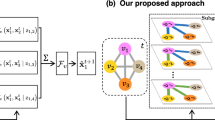Abstract
Much work has been recently proposed to model relational data, especially in the multi-relational case, where different kinds of relationships are used to connect the various data entities. Previous attempts either consist of powerful systems with high capacity to model complex connectivity patterns, which unfortunately usually end up overfitting on rare relationships, or in approaches that trade capacity for simplicity in order to fairly model all relationships, frequent or not. In this paper, we propose a happy medium obtained by complementing a high-capacity model with a simpler one, both pre-trained separately and jointly fine-tuned. We show that our approach outperforms existing models on different types of relationships, and achieves state-of-the-art results on two benchmarks of the literature.
Chapter PDF
Similar content being viewed by others
References
Bordes, A., Weston, J., Collobert, R., Bengio, Y.: Learning structured embeddings of knowledge bases. In: Proc. of the 25th Conf. on Artif. Intel. (AAAI) (2011)
Bordes, A., Glorot, X., Weston, J., Bengio, Y.: A semantic matching energy function for learning with multi-relational data. Machine Learning (2013)
Bordes, A., Usunier, N., Garcia-Duran, A., Weston, J., Yakhnenko, O.: Translating embeddings for modeling multi-relational data. In: Advances in Neural Information Processing Systems, pp. 2787–2795 (2013)
Collobert, R., Weston, J., Bottou, L., Karlen, M., Kavukcuoglu, K., Kuksa, P.: Natural language processing (almost) from scratch. Journal of Machine Learning Research 12, 2493–2537 (2011)
Franz, T., Schultz, A., Sizov, S., Staab, S.: Triplerank: Ranking semantic web data by tensor decomposition. In: Bernstein, A., Karger, D.R., Heath, T., Feigenbaum, L., Maynard, D., Motta, E., Thirunarayan, K. (eds.) ISWC 2009. LNCS, vol. 5823, pp. 213–228. Springer, Heidelberg (2009)
Grandvalet, Y.: Least absolute shrinkage is equivalent to quadratic penalization. In: The International Conference on Artificial Neural Networks (1998)
Harshman, R., Lundy, M.: Three-way dedicom: Analyzing multiple matrices of asymmetric relationships. An. Meeting of the N. Amer. Psych. Society (1992)
Harshman, R.A., Lundy, M.E.: Parafac: parallel factor analysis. Comput. Stat. Data Anal. 18(1), 39–72 (1994)
Jenatton, R., Le Roux, N., Bordes, A., Obozinski, G., et al.: A latent factor model for highly multi-relational data. In: NIPS 25 (2012)
Kemp, C., Tenenbaum, J.B., Griffiths, T.L., Yamada, T., Ueda, N.: Learning systems of concepts with an infinite relational model. In: Proc. of the 21st National Conf. on Artif. Intel. (AAAI), pp. 381–388 (2006)
Kok, S., Domingos, P.: Statistical predicate invention. In: Proceedings of the 24th International Conference on Machine Learning, ICML 2007 pp. 433–440 (2007)
Koren, Y., Bell, R., Volinsky, C.: Matrix factorization techniques for recommender systems. Computer 42(8), 30–37 (2009)
Lao, N., Mitchell, T., Cohen, W.W.: Random walk inference and learning in a large scale knowledge base. In: Proceedings of the Conference on Empirical Methods in Natural Language Processing, pp. 529–539. Association for Computational Linguistics (2011)
Mikolov, T., Sutskever, I., Chen, K., Corrado, G.S., Dean, J.: Distributed representations of words and phrases and their compositionality. In: Advances in Neural Information Processing Systems, pp. 3111–3119 (2013)
Miller, G.: WordNet: a Lexical Database for English. Communications of the ACM 38(11), 39–41 (1995)
Miller, K., Griffiths, T., Jordan, M.: Nonparametric latent feature models for link prediction. In: Bengio, Y., Schuurmans, D., Lafferty, J., Williams, C.K.I., Culotta, A. (eds.) Advances in Neural Information Processing Systems 22 (2009)
Nickel, M., Tresp, V., Kriegel, H.P.: A three-way model for collective learning on multi-relational data. In: Proceedings of the 28th International Conference on Machine Learning (ICML 2011), pp. 809–816 (2011)
Nickel, M., Tresp, V., Kriegel, H.P.: Factorizing yago: scalable machine learning for linked data. In: Proceedings of the 21st International Conference on World Wide Web, WWW 2012, pp. 271–280 (2012)
Paccanaro, A., Hinton, G.: Learning distributed representations of concepts using linear relational embedding. IEEE Trans. on Knowl. and Data Eng. 13 (2001)
Salakhutdinov, R., Srebro, N.: Collaborative filtering in a non-uniform world: Learning with the weighted trace norm. tc (X) 10, 2 (2010)
Socher, R., Chen, D., Manning, C.D., Ng, A.Y.: Reasoning With Neural Tensor Networks For Knowledge Base Completion. In: Advances in Neural Information Processing Systems 26 (2013)
Sutskever, I., Salakhutdinov, R., Tenenbaum, J.: Modelling relational data using bayesian clustered tensor factorization. In: Adv. in Neur. Inf. Proc. Syst. 22 (2009)
Tucker, L.R.: Some mathematical notes on three-mode factor analysis. Psychometrika 31, 279–311 (1966)
Zhu, J.: Max-margin nonparametric latent feature models for link prediction. In: Proceedings of the 29th Intl Conference on Machine Learning (2012)
Author information
Authors and Affiliations
Editor information
Editors and Affiliations
Rights and permissions
Copyright information
© 2014 Springer-Verlag Berlin Heidelberg
About this paper
Cite this paper
García-Durán, A., Bordes, A., Usunier, N. (2014). Effective Blending of Two and Three-way Interactions for Modeling Multi-relational Data. In: Calders, T., Esposito, F., Hüllermeier, E., Meo, R. (eds) Machine Learning and Knowledge Discovery in Databases. ECML PKDD 2014. Lecture Notes in Computer Science(), vol 8724. Springer, Berlin, Heidelberg. https://doi.org/10.1007/978-3-662-44848-9_28
Download citation
DOI: https://doi.org/10.1007/978-3-662-44848-9_28
Publisher Name: Springer, Berlin, Heidelberg
Print ISBN: 978-3-662-44847-2
Online ISBN: 978-3-662-44848-9
eBook Packages: Computer ScienceComputer Science (R0)




